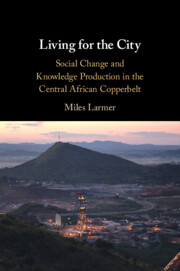Book contents
- Living for the City
- Living for the City
- Copyright page
- Dedication
- Contents
- Figures
- Acknowledgements
- Abbreviations and Acronyms
- Introduction
- 1 Imagining the Copperbelts
- 2 Boom Time – Revisiting Capital and Labour in the Copperbelt
- 3 Space, Segregation and Socialisation
- 4 Political Activism, Organisation and Change in the Late Colonial Copperbelt
- 5 Gendering the Copperbelt
- 6 Nationalism and Nationalisation
- 7 Copperbelt Cultures from the Kalela Dance to the Beautiful Time
- 8 Decline and Fall: Crisis and the Copperbelt, 1975–2000
- 9 Remaking the Land: Environmental Change in the Copperbelt’s History, Present and Future
- Conclusion
- References
- Index
- References
References
Published online by Cambridge University Press: 06 August 2021
- Living for the City
- Living for the City
- Copyright page
- Dedication
- Contents
- Figures
- Acknowledgements
- Abbreviations and Acronyms
- Introduction
- 1 Imagining the Copperbelts
- 2 Boom Time – Revisiting Capital and Labour in the Copperbelt
- 3 Space, Segregation and Socialisation
- 4 Political Activism, Organisation and Change in the Late Colonial Copperbelt
- 5 Gendering the Copperbelt
- 6 Nationalism and Nationalisation
- 7 Copperbelt Cultures from the Kalela Dance to the Beautiful Time
- 8 Decline and Fall: Crisis and the Copperbelt, 1975–2000
- 9 Remaking the Land: Environmental Change in the Copperbelt’s History, Present and Future
- Conclusion
- References
- Index
- References
Summary
- Type
- Chapter
- Information
- Living for the CitySocial Change and Knowledge Production in the Central African Copperbelt, pp. 336 - 371Publisher: Cambridge University PressPrint publication year: 2021
- Creative Commons
- This content is Open Access and distributed under the terms of the Creative Commons Attribution licence CC-BY-NC-ND 4.0 https://creativecommons.org/cclicenses/

